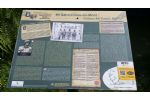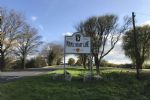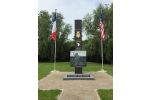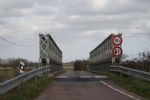Hell's Corner
Cette écluse était l'un des objectifs (The strategic lock) du 501st Parachute Infantry Regiment (PIR) de la 101st Airborne américaine lors du débarquement allié du 6 juin 1944. Il s'agissait de prendre l'ouvrage pour que les Allemands n'inondent pas la zone des combats. Or, les marais étaient déjà inondés mais cela n'était pas visible sur les photos aériennes à cause des hautes herbes qui recouvraient l'endroit, donnant l'illusion d'une prairie sèche.
Le colonel Howard R. "Skeets" Johnson (1903-1944), commandant du 501st PIR, arriva à la Barquette aux premières lueurs de l'aube du 6 juin, pataugeant ou nageant avec 150 hommes qui venaient du 1st Battalion, du 2nd Battalion et de la HQ Company. Une trentaine de paras du 506th PIR se joignirent temporairement à eux mais poursuivirent vers l'est, jusqu'au Port de Brévands où ils devaient occuper deux ponts sur la Douve.
Johnson ordonna à cinquante soldats de traverser l'écluse et d'occuper la rive sud. Les autres parachutistes établirent une position défensive sur la rive nord pour prévenir toute contre-attaque de ce côté. L'extrémité sud de l'écluse était totalement déserte et les bâtiments autour parfaitement vides. Les paras occupèrent donc les lieux et creusèrent des trous pour s'abriter des tirs sporadique de mortiers et d'armes automatiques dont ils avaient du mal à juger la provenance.
À 6h00 du matin, l'écluse de la Barquette était donc sous contrôle mais "Skeets" Johnson jugeait sa position peu confortable. Il souhaitait renforcer sa troupe et pour cela, il prit la direction d'un petit groupe pour aller chercher le major Allen qui avait réussi de son côté à rassembler une centaine d'hommes, avec lesquels il avait engagé des Allemands à Basse-Addeville. Alors que le groupe renforcé rejoignait l'écluse en début d'après-midi, il fut pris sous le feu de mortiers et de 88 situés sur les hauteurs. Le colonel H.R. Johnson demanda alors l'appui du croiseur USS Quincy pour faire taire les batteries allemandes.
Johnson passa l'après-midi à renforcer sa position des deux côtés du fleuve en déployant les deux-cent cinquante hommes dont il disposait désormais. Il envoya des patrouilles aux alentours ainsi qu'un groupe qui échoua à dynamiter le pont de la N13 sur la Douve, le feu étant trop nourri de ce côté-là. Les paras étaient toujours l'objet de tirs sporadiques, mais les Allemands ne firent aucune tentative sérieuse pour reprendre l'écluse.
Le matin du 7 juin, les tirs d'artillerie reprirent. En fin d'après-midi, des Allemands du 1/FJ reg 6 (1er bataillon du 6e régiment parachutiste allemand) retraitaient vers Carentan à travers les marais inondés, sans soupçonner que des parachutistes américains étaient positionnés à la Barquette. Voyant venir la troupe, Johnson organisa une embuscade en retournant le gros de ses forces face au nord, avec six de ses huit mitrailleuses. Lors du combat qui suivit, les Allemands subirent des pertes sévères : 150 victimes (tués ou blessés) et 350 prisonniers. Une vingtaine seulement réussirent à regagner leurs lignes. Les Américains déplorèrent, quant à eux, 10 tués et 30 blessés. Ils surnommèrent l'endroit Hell's Corner (le Carrefour de l'enfer), là où deux chemins se rejoignent, formant un « Y ».
La prise de cette position s'avéra inutile sur le moment car les marais étaient déjà inondés. Elle permit quand même de surveiller le franchissement du fleuve et facilita indirectement la partie nord de l'attaque américaine sur Carentan qui se déclencha le samedi 10 juin à hauteur de Brévands, ainsi que l'assaut frontal meurtrier qui emprunta, le lendemain, la chaussée de la route nationale.
source wikimanche








